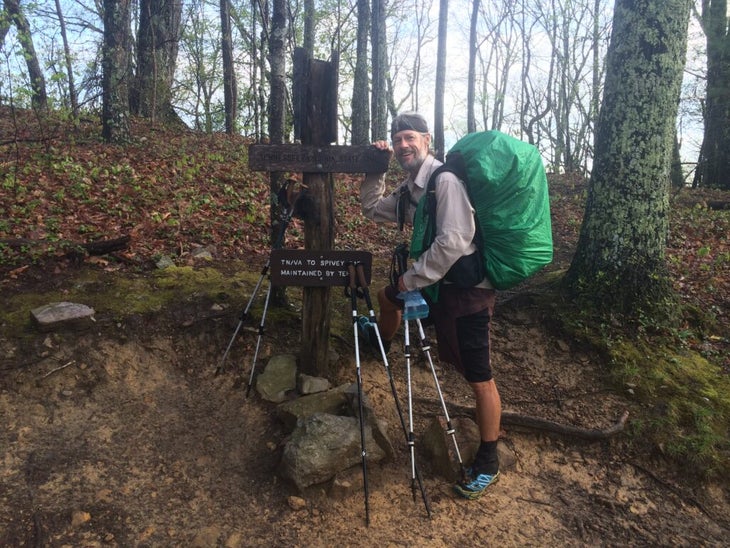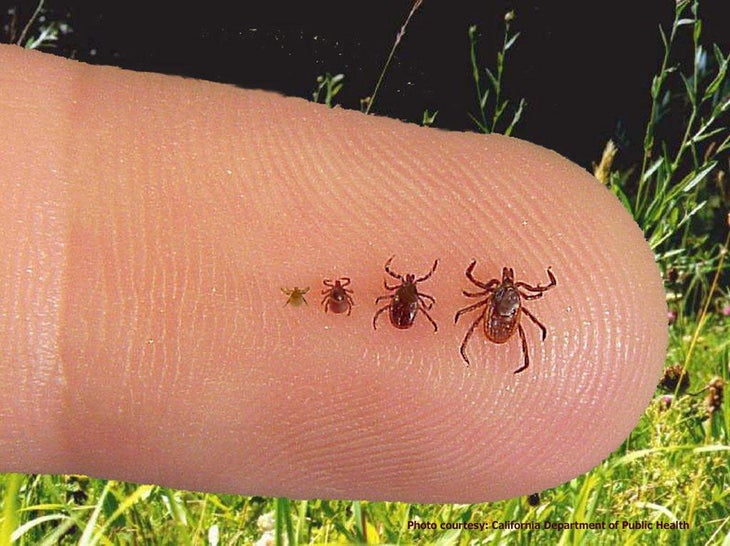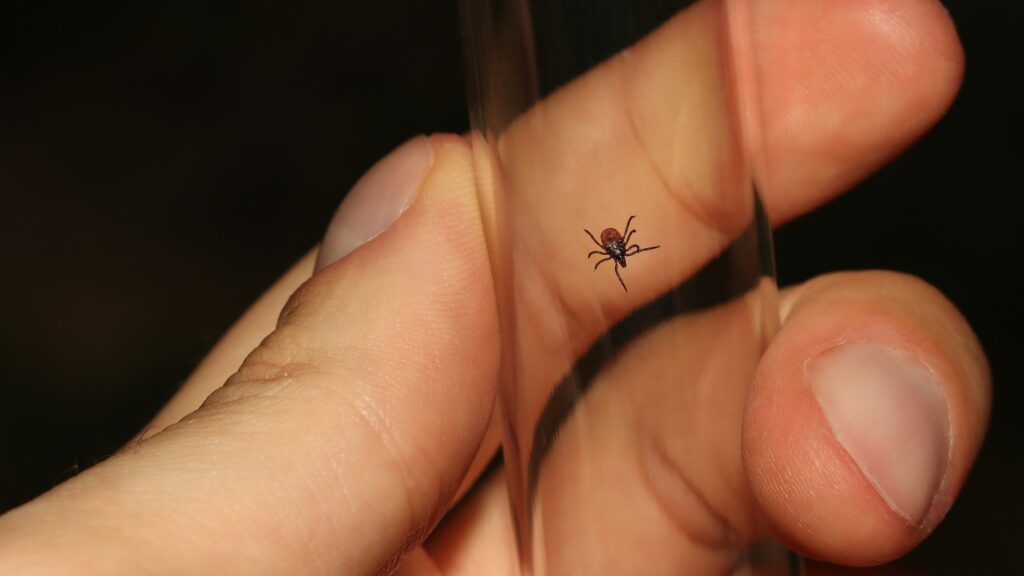“], “filter”: { “nextExceptions”: “img, blockquote, div”, “nextContainsExceptions”: “img, blockquote, a.btn, a.o-button”} }”>
Heading out the door? Read this article on the new Outside+ app available now on iOS devices for members!
>”,”name”:”in-content-cta”,”type”:”link”}}”>Download the app.
Clay Bonnyman Evans was sweating his way through the rocky Pennsylvania section of the Appalachian Trail when he started to feel sick.
“I was alternating between shivering and being incredibly hot,” he says. “My knees started to creak really badly, which was not normal, and I just stopped eating.” Evans’s burly 25-mile days slowed to 8 miles per day, then to 5. “I was totally blasted,” he says.
Eventually, Evans crawled up to the Rausch shelter northeast of Harrisburg. “It was 90-something degrees and super humid,” he says, “and I just lay there.” A local hiker passed by, saw Evans’s body in a heap, and asked what was going on. “I said, ‘Yeah I think I have the flu or something,’” says Evans. The hiker looked at him for a moment and then responded: “Well, you might have Lyme disease.”
Lyme’s rapid rise
Although big mammals are front of mind in the backcountry, it’s often the smaller creatures that pose the biggest health risks—from invisible noroviruses in your Nalgene to disease-carrying mosquitoes. But if you’re backpacking in the U.S. or Canada this summer, ticks are the little perils that reign supreme.
“Here in Minnesota, we have wolves and bears,” says Jon Oliver, a professor of public health at the University of Minnesota and a tick expert. “But ticks are definitely number one in terms of hazards here.” Indeed, across the U.S., ticks cause more illness than any other parasite combined, and the most common of those illnesses by far is Lyme.
Lyme disease, named for the Connecticut town where it was first identified, infects half a million people per year in the U.S.—higher than the number of annual Malaria infections in all of Latin America. Lyme disease was once restricted in scope, both geographically and in terms of the number of people it infected. But for reasons that aren’t fully understood—perhaps climate change, perhaps expanding deer populations—Lyme is now on a tear across the country, with reported cases of the disease having doubled since the 90s.
The mysterious ways of ticks
Lyme disease is only spread by the deer tick (sometimes called the black-legged tick), an inconspicuous brown parasite with no eyes, a tiny head, and a literal thirst for blood. These ticks wait at the end of leaves and grass for weeks at a time, waving their forelegs frantically in a behavior called “questing.” This frenzied macarena allows specialized organs in the ticks’ feet to detect the breath, sweat, and heat signature of their warm-blooded hosts.
Once a tick makes it onto your body, it is exceedingly difficult to feel. In his book The Forest Unseen, the ecologist David George Haskell suggests that the arachnids might “charm our nerve endings,” through some unknown physiological process—something akin to Fremen sandwalking on the Planet Dune, trying not to alert the giant worms to their presence. The deer tick only needs to feed three times in its two-to-three-year life, so it can afford to be patient.
Lyme disease is caused by a bacteria called Borrelia that lives in the tick’s gut. Right now, the Northeast and northern Midwest are the most Lyme-riddled parts of the country: According to local surveys, in some areas, up to 50 percent of ticks currently carry the disease. Cases of Lyme are also increasing in the South and along the Pacific coast. Other regions, however, have their own dreadful flavors of tick-incubated illness, from Rocky Mountain spotted fever to Alpha-gal syndrome.
Getting lucky
Contracting Lyme is a bit of a dice roll. Many people experience flu-like symptoms and joint pain for a few days and then recover, especially with prompt treatment. Although this prognosis doesn’t sound so bad if you’re at home, it can be downright incapacitating on the trail.
Evans, who has 10,000 miles of backpacking under his belt, and is 200 miles short of a Triple Crown, calls his days of Lyme symptoms “the worst days of thru-hiking I’ve ever had.” And that’s really saying something.

He eventually reached the emergency room with a 103.5-degree fever. It was too early to test for Lyme (it can take weeks for the bacteria to show up in a blood test), but a rash on his waist, and his now acutely relevant recollection of having pulled “many, many ticks” off his body over the preceding weeks, were enough evidence for the doctor. Evans spent three days recuperating in a tent in Port Clinton, Pennsylvania on a heavy dosage of the common antibiotic Doxycycline and eventually continued his hike. Months later, a lab test confirmed that he had Lyme.
As challenging as Evans’s illness was, he can count himself lucky: Aside from some lingering fatigue, his symptoms mostly subsided a few days after taking medication. That’s not everyone’s experience. Around 5 to 10 percent of people who contract Lyme never really get over it. These patients develop a condition known as “post-treatment Lyme disease syndrome,” or PTLDS.
Holiday Goodreau’s daughter, Olivia, was one of those patients. Six weeks after a vacation to Lake of the Ozarks in Missouri, Olivia became extremely fatigued. “She couldn’t hold her head up,” says Goodreau, who’s now the Executive Director of the LivLyme Foundation, a Colorado-based nonprofit her daughter later founded. The organization raises money for Lyme disease research and treatment.
Olivia never developed the “bullseye” rash often associated with Lyme. That, coupled with the fact that the family lives in Denver, where Lyme is rare, meant that it took 18 months and dozens of doctors for Olivia to finally be diagnosed with the disease. The family later pieced together that she picked it up from the trip to Missouri.
Treatments on the horizon
There is bitter disagreement in the medical community about how to treat PTLDS, and different doctors offer a range of treatments. Some medicines are promising but experimental, and some are probably closer to snake oil. None of these treatments were effective for Olivia Goodreau, who’s now a college student and still suffers from PTLDS symptoms. The saga has been a difficult one, for both her and her family.
On an airplane to the East Coast recently, Goodreau recalled looking out over a beautiful expanse of deciduous forest and just feeling her skin crawl. “All I see are ticks,” she says.
There are currently no FDA-approved treatments for PTLDS, and according to the CDC, our understanding of the syndrome is still quite limited. However, there could be some hope on the horizon. A few promising Lyme treatments are now in the research phase. Biotech companies Pfizer and Valneva are both expected to conclude clinical trials and apply for approval for vaccines as soon as 2026. The vaccines have the potential to inoculate patients against Lyme disease, significantly reducing the odds of infection. There’s also an oral medication in the works that’s designed to kill any ticks that have latched on. This medicine could remain effective against the parasites for up to 30 days after dosing.
“I think within the next five to 10 years, a lot is going to happen in this space of prevention and testing, and with vaccines and new drugs,” says Goodreau.
How to dodge a bite
In the meantime, the best way to avoid Lyme is by avoiding bites. Oliver says fear of ticks shouldn’t keep you from enjoying the outdoors. But, he adds, “I am definitely well aware of the risks, and take every precaution to avoid tick bites.”
Step one: Educate yourself about whether Lyme is active where you’re hiking. This CDC map is a good place to start. Then, be proactive about checking for ticks and washing your clothing as soon as you get home from a hike.

The good news is that Lyme transmission isn’t instant; a tick must be attached for more than 24 hours to transmit the disease. So, tick checks and proactive removal are some of your biggest defenses. Be careful not to overlook the poppyseed-sized young ticks known as nymphs. “These are the ones that you most have to look out for,” says Oliver. Though, he notes, they’re slightly less likely to carry Lyme disease than adult ticks.
Wearing long sleeves, as well as treating your clothing with an insect repellant, can also go a long way toward prevention. Oliver recommends spraying your skin and or clothing with DEET, permethrin, or oil of lemon eucalyptus. If you do find an engorged tick, that means it’s been on you long enough to transmit a disease and it’s time to go to a doctor—even if you don’t have symptoms, says Oliver.
“You really don’t want this [disease], on trail or anywhere else,” warns Evans.
Holiday Goodreau agrees: “One tick can change your life forever.”
